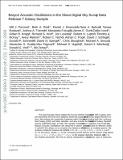Baryon Acoustic Oscillations in the Sloan Digital Sky Survey Data Release 7 Galaxy Sample
Author(s)
Percival, Will J.; Reid, Beth A.; Eisenstein, Daniel J.; Bahcall, Neta A.; Budavari, Tamas; Frieman, Joshua A.; Fukugita, Masataka; Gunn, James E.; Ivezic, Zeljko; Knapp, Gillian R.; Kron, Richard G.; Loveday, Jon; Lupton, Robert H.; McKay, Timothy A.; Meiksin, Avery; Nichol, Robert C.; Pope, Adrian C.; Schlegel, David J.; Schneider, Donald P.; Spergel, David N.; Stoughton, Chris; Strauss, Michael A.; Szalay, Alexander S.; Tegmark, Max Erik; Vogeley, Michael S.; Weinberg, David H.; York, Donald G.; Zehavi, Idit; ... Show more Show less
DownloadTegmark_BaryonAcoustic.pdf (1.138Mb)
OPEN_ACCESS_POLICY
Open Access Policy
Creative Commons Attribution-Noncommercial-Share Alike
Terms of use
Metadata
Show full item recordAbstract
The spectroscopic Sloan Digital Sky Survey (SDSS) Data Release 7 (DR7) galaxy sample represents the final set of galaxies observed using the original SDSS target selection criteria. We analyse the clustering of galaxies within this sample, including both the luminous red galaxy and main samples, and also include the 2-degree Field Galaxy Redshift Survey data. In total, this sample comprises 893 319 galaxies over 9100 deg2. Baryon acoustic oscillations (BAO) are observed in power spectra measured for different slices in redshift; this allows us to constrain the distance–redshift relation at multiple epochs. We achieve a distance measure at redshift z= 0.275, of rs(zd)/DV(0.275) = 0.1390 ± 0.0037 (2.7 per cent accuracy), where rs(zd) is the comoving sound horizon at the baryon-drag epoch, DV(z) ≡[(1 +z)2D2Acz/H(z)]1/3, DA(z) is the angular diameter distance and H(z) is the Hubble parameter. We find an almost independent constraint on the ratio of distances DV(0.35)/DV(0.2) = 1.736 ± 0.065, which is consistent at the 1.1sigma level with the best-fitting Λ cold dark matter model obtained when combining our z= 0.275 distance constraint with the Wilkinson Microwave Anisotropy Probe 5-year (WMAP5) data. The offset is similar to that found in previous analyses of the SDSS DR5 sample, but the discrepancy is now of lower significance, a change caused by a revised error analysis and a change in the methodology adopted, as well as the addition of more data. Using WMAP5 constraints on Ωbh2 and Ωc h2, and combining our BAO distance measurements with those from the Union supernova sample, places a tight constraint on Omegam= 0.286 ± 0.018 and H0= 68.2 ± 2.2 km s−1 Mpc−1 that is robust to allowing Omegak≠ 0 and w≠−1. This result is independent of the behaviour of dark energy at redshifts greater than those probed by the BAO and supernova measurements. Combining these data sets with the full WMAP5 likelihood constraints provides tight constraints on both Omegak=−0.006 ± 0.008 and w=−0.97 ± 0.10 for a constant dark energy equation of state.
Date issued
2010-02Department
Massachusetts Institute of Technology. Department of PhysicsJournal
Monthly Notices of the Royal Astronomical Society
Publisher
Oxford University Press
Citation
Percival, Will J. et al. “Baryon Acoustic Oscillations in the Sloan Digital Sky Survey Data Release 7 Galaxy Sample.” Monthly Notices of the Royal Astronomical Society 401.4 (2010): 2148–2168. Web.
Version: Author's final manuscript
ISSN
0035-8711
1365-8711